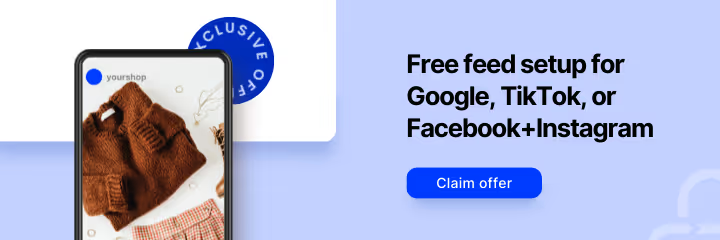Google tends to diversify search results as much as possible -- unless it’s certain of the searcher’s intent and, even for Google, that's a tough ask.
Even in cases where it’s mostly sure that the user is searching for a specific brand, Google will throw similar brands and products into the mix. Here’s an example:

In this case, Google Shopping's algorithm matches my search with similar users’ behavior (what they’ve clicked on after similar queries). Additionally, the SERP includes other products that might be of interest to me.
As you can see, the SERP is a 50/50 split between brand-accurate search results and other brands/other sellers.
Google takes its cues from your domain as well as these fields in your feed:
- Brand
- GTIN
- Title
- Description
If done properly, these feed fields along with your domain, will be enough for Google Shopping to identify your brand and serve the right product listing ads to shoppers searching for your brand.
Of course, you can try optimizing for your brand’s keywords (i.e., your branded terms), but be aware that you could run the risk of over-optimizing for branded terms. This could leave your listings unoptimized for important non-branded keywords, limiting your reach for product-specific, industry and competitor search terms.
Unless your branded terms are the main search drivers for your Google Shopping campaigns, we recommend optimizing evenly between branded and non-branded terms.
To see what keywords are driving impressions and clicks, go to the Search Terms report in your Google Ads dashboard. This will give you an idea of what keywords Google Shopping is associating with your PLAs. Here, you can determine if Google is correctly indexing your brand's keywords.
Optimizing PLAs for Branded Search Terms
1. Make sure this is an actual need for your campaigns.
- Open an Incognito tab in Google Chrome
- Perform branded searches for your PLAs
- Perform branded searches for at least 3 competitors' PLAs
- Compare your brand SERPs to your competitors' brand SERPs
2. Determine if there's a need for brand optimization.
If your brand SERPs are unbalanced... If your brand SERPs are showing fewer of your PLAs than other brands'... If your brand SERPs are disorganized, not really showing a cohesive collection of your products (albeit with some competitor products mixed in)... then it’s time to optimize PLAs for your brand.
3. Revisit SERP ranking factors (mentioned above).
If your brand and domain don't match, the problem could stem from domain confusion as Andrew Allemann from Name Cheap explains here.
If a branded domain isn't the issue, you need to review the data in your Google Shopping feed. Specifically these fields:
Brand
Of course you want your brand name here. But what if your brand name is missing categorical cues? In some cases, it could be beneficial to add category terms to your brand in order to help Google Shopping identify shopper intent.
More on this in the section below.
GTIN
The Global Trade Item Number is a unique and internationally recognized identifier for a product. Registering your brand's GTINs will play a huge role in helping Google index and sort your products.
Title / Description
More than anything, Google Shopping looks at product titles and descriptions for keywords. So... Make sure your brand is present in both Title and Description.
I recommend using 150 to 500 words in descriptions. Mix branded terms with product/category/industry terms as variations.
For example, if my brand is Breakwater and I sell sunglasses, I would use Breakwater Sunglasses in my titles. I would also use the following variations of my brand in my descriptions:
- Breakwater sunglasses
- Breakwater specs
- Breakwater shades
- Breakwater glasses
- Breakwater frames
- Breakwater lenses
This will create a richer product profile for Google to go by.
If your descriptions are short because your website uses a minimalist approach to text and design, use a merge file to supplement your PLAs without cluttering up your product pages.
Complement Your Brand With Category Keywords
Additionally, if you know (based on keyword research) that your shoppers search using specific search terms associated with your brand, you might want to add that search term in your Brand field.
If currently, your brand field is just “BRAND NAME” but Google has that brand also registered for other brands in other product categories (we see this happen all the time), it could dilute your products strength in search results.
Example:
Brand: Breakwater | Category: Apparel & Accessories > Clothing Accessories > Sunglasses

Brand: Breakwater Bay | Category: Home & Garden > Lighting > Lamps
Optimizing for Brand-Relevant Unbranded Terms
Similarly, if you wanted to capitalize not just on your brand but also on Google’s recognition of user intent, optimize your PLAs by adding unbranded but relevant keywords into your titles and descriptions.
In the sunglasses search example above, in order to differentiate the Breakwater (Sunglasses) brand from Breakwater Bay (Lighting) brand, I would include terms like:
- Sunglasses
- Polarized
- Shades

This will give Google’s algorithm a broader field of keywords to work with. It will also help steer Google’s understanding of the brand toward the correct category.
Final Notes
Optimization is an ongoing process. The recommendations above are intended to help Google index your products for your branded terms. If not done thoughtfully, such optimizations can push Google too much toward branded terms and away from general relevant terms, so beware this double-sided coin.
We recommend A/B testing optimization strategies on a small batch of products to measure results on a limited set of products before committing to the changes. Additionally, we suggest making changes to your feed (using rules) and NOT to your website’s product pages.




%20).png)

%20).png)